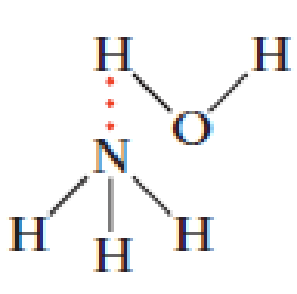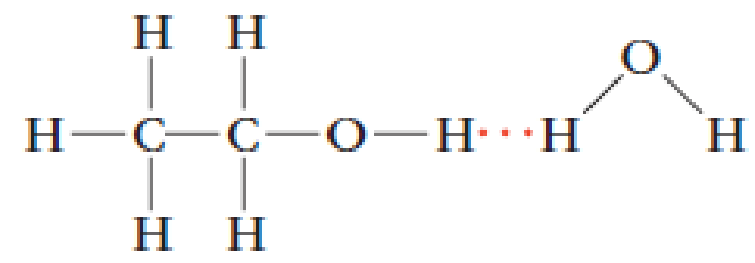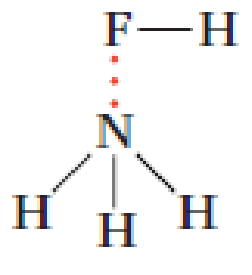
OWLV2 FOR MOORE/STANITSKI'S CHEMISTRY:
5th Edition
ISBN: 9781285460369
Author: STANITSKI
Publisher: Cengage Learning
expand_more
expand_more
format_list_bulleted
Concept explainers
Textbook Question
Chapter 7, Problem 95QRT
Which of these are examples of hydrogen bonding?




Expert Solution & Answer
Trending nowThis is a popular solution!

Students have asked these similar questions
Synthesize 2-Hydroxy-2-phenylacetonitrile from phenylmethanol using the necessary organic or inorganic reagents. Draw the structures of the compounds.
Synthesize N-Methylcyclohexylamine from cyclohexanol using the necessary organic or inorganic reagents. Draw the structures of the compounds.
Synthesize N-Methylcyclohexylamine from cyclohexanol using the necessary organic or inorganic reagents. Draw the structures of the compounds.
Chapter 7 Solutions
OWLV2 FOR MOORE/STANITSKI'S CHEMISTRY:
Ch. 7.2 - Identify the electron-region geometry, the...Ch. 7.2 - Based on the discussion so far, identify a...Ch. 7.2 - Prob. 7.2PSPCh. 7.2 - Determine the electron-region geometry and the...Ch. 7.2 - Prob. 7.2CECh. 7.2 - Prob. 7.3ECh. 7.2 - Prob. 7.4PSPCh. 7.4 - Using hybridization and sigma and pi bonding,...Ch. 7.4 - Prob. 7.4CECh. 7.5 - Decide whether each molecule is polar and, if so,...
Ch. 7.5 - Prob. 7.5ECh. 7.6 - Prob. 7.8PSPCh. 7.6 - Prob. 7.7CECh. 7.6 - Prob. 7.9PSPCh. 7.7 - Prob. 7.8CECh. 7.7 - Prob. 7.9CECh. 7 - Write the Lewis structures and give the...Ch. 7 - The structural formula for the open-chain form of...Ch. 7 - Describe the VSEPR model. How is the model used to...Ch. 7 - What is the difference between the electron-region...Ch. 7 - Prob. 3QRTCh. 7 - Prob. 4QRTCh. 7 - If you have three electron regions around a...Ch. 7 - Prob. 6QRTCh. 7 - Prob. 7QRTCh. 7 - Prob. 8QRTCh. 7 - Prob. 9QRTCh. 7 - Prob. 10QRTCh. 7 - Prob. 11QRTCh. 7 - Prob. 12QRTCh. 7 - Prob. 13QRTCh. 7 - Prob. 14QRTCh. 7 - Prob. 15QRTCh. 7 - Prob. 16QRTCh. 7 - Write Lewis structures for XeOF2 and ClOF3. Use...Ch. 7 - Write Lewis structures for HCP and [IOF4]. Use...Ch. 7 - Prob. 19QRTCh. 7 - Prob. 20QRTCh. 7 - Explain why (I3)+ is bent, but (I3) is linear.Ch. 7 - Prob. 22QRTCh. 7 - Prob. 23QRTCh. 7 - Give approximate values for the indicated bond...Ch. 7 - Give approximate values for the indicated bond...Ch. 7 - Prob. 26QRTCh. 7 - Compare the FClF angles in ClF2+ and ClF2. From...Ch. 7 - Prob. 28QRTCh. 7 - Prob. 29QRTCh. 7 - Prob. 30QRTCh. 7 - Prob. 31QRTCh. 7 - Describe the geometry and hybridization of carbon...Ch. 7 - Describe the geometry and hybridization for each C...Ch. 7 - Describe the hybridization around the central atom...Ch. 7 - The hybridization of the two carbon atoms differs...Ch. 7 - The hybridization of the two nitrogen atoms...Ch. 7 - Identify the type of hybridization, approximate...Ch. 7 - Prob. 38QRTCh. 7 - Prob. 39QRTCh. 7 - Prob. 40QRTCh. 7 - Prob. 41QRTCh. 7 - Methylcyanoacrylate is the active ingredient in...Ch. 7 - Prob. 43QRTCh. 7 - Prob. 44QRTCh. 7 - Prob. 45QRTCh. 7 - Prob. 46QRTCh. 7 - Which of these molecules has a net dipole moment?...Ch. 7 - Prob. 48QRTCh. 7 - Use molecular structures and noncovalent...Ch. 7 - Prob. 50QRTCh. 7 - Explain why water “beads up” on a freshly waxed...Ch. 7 - Explain why water will not remove tar from your...Ch. 7 - Prob. 53QRTCh. 7 - Prob. 54QRTCh. 7 - Prob. 55QRTCh. 7 - Prob. 56QRTCh. 7 - The structural formula for vitamin C is Give a...Ch. 7 - Prob. 58QRTCh. 7 - Prob. 59QRTCh. 7 - Prob. 60QRTCh. 7 - Prob. 61QRTCh. 7 - Prob. 62QRTCh. 7 - Prob. 63QRTCh. 7 - Prob. 64QRTCh. 7 - Prob. 65QRTCh. 7 - Prob. 66QRTCh. 7 - Methylcyanoacrylate is the active ingredient in...Ch. 7 - Prob. 68QRTCh. 7 - Prob. 69QRTCh. 7 - Use Lewis structures and VSEPR theory to predict...Ch. 7 - In addition to CO, CO2, and C3O2, there is another...Ch. 7 - Prob. 72QRTCh. 7 - Prob. 73QRTCh. 7 - Prob. 74QRTCh. 7 - Prob. 75QRTCh. 7 - In the gas phase, positive and negative ions form...Ch. 7 - Prob. 77QRTCh. 7 - Prob. 78QRTCh. 7 - Prob. 79QRTCh. 7 - Prob. 80QRTCh. 7 - Prob. 81QRTCh. 7 - Prob. 82QRTCh. 7 - Prob. 83QRTCh. 7 - Prob. 84QRTCh. 7 - Prob. 85QRTCh. 7 - Prob. 86QRTCh. 7 - Prob. 87QRTCh. 7 - Prob. 88QRTCh. 7 - Prob. 89QRTCh. 7 - Prob. 90QRTCh. 7 - Prob. 91QRTCh. 7 - Prob. 92QRTCh. 7 - Prob. 93QRTCh. 7 - Prob. 94QRTCh. 7 - Which of these are examples of hydrogen bonding?Ch. 7 - Prob. 96QRTCh. 7 - Prob. 97QRTCh. 7 - Prob. 98QRTCh. 7 - Halothane, which had been used as an anesthetic,...Ch. 7 - Ketene, C2H2O, is a reactant for synthesizing...Ch. 7 - Gamma hydroxybutyric acid, GHB, infamous as a date...Ch. 7 - There are two compounds with the molecular formula...Ch. 7 - Piperine, the active ingredient in black pepper,...Ch. 7 - Prob. 105QRTCh. 7 - Two compounds have the molecular formula N3H3. One...Ch. 7 - Prob. 108QRTCh. 7 - Prob. 109QRTCh. 7 - Prob. 110QRTCh. 7 - Prob. 111QRTCh. 7 - Prob. 7.ACPCh. 7 - Prob. 7.BCPCh. 7 - Prob. 7.CCPCh. 7 - Prob. 7.DCP
Knowledge Booster
Learn more about
Need a deep-dive on the concept behind this application? Look no further. Learn more about this topic, chemistry and related others by exploring similar questions and additional content below.Similar questions
- If possible, please provide the formula of the compound 3,3-dimethylbut-2-enal.arrow_forwardSynthesize 1,4-dibromobenzene from acetanilide (N-phenylacetamide) using the necessary organic or inorganic reagents. Draw the structures of the compounds.arrow_forwardIndicate the products obtained by mixing (3-oxo-3-phenylpropyl)triphenylphosphonium bromide with sodium hydride.arrow_forward
- We mix N-ethyl-2-hexanamine with excess methyl iodide and followed by heating with aqueous Ag2O. Indicate the major products obtained.arrow_forwardIndicate the products obtained by mixing acetophenone with iodine and NaOH.arrow_forwardIndicate the products obtained by mixing 2-Propanone and ethyllithium and performing a subsequent acid hydrolysis.arrow_forward
- Indicate the products obtained if (E)-2-butenal and 3-oxo-butanenitrile are mixed with sodium ethoxide in ethanol.arrow_forwardQuestion 3 (4 points), Draw a full arrow-pushing mechanism for the following reaction Please draw all structures clearly. Note that this intramolecular cyclization is analogous to the mechanism for halohydrin formation. COH Br + HBr Brarrow_forwardIndicate the products obtained if 2,2-dimethylpropanal and acetaldehyde are mixed with sodium ethoxide in ethanol.arrow_forward
- Indicate the products obtained if 2,2-dimethylpropanal and acetaldehyde are reacted with sodium ethoxide in ethanol.arrow_forward2,2-Dimethylpropanal and acetaldehyde are reacted with sodium ethoxide in ethanol. Indicate the products obtained.arrow_forwardAdd conditions above and below the arrow that turn the reactant below into the product below in a single transformationADS fint anditions 百 Abl res condinese NC ง Add on condtions 1.0 B H,N.arrow_forward
arrow_back_ios
SEE MORE QUESTIONS
arrow_forward_ios
Recommended textbooks for you
 Chemistry: The Molecular ScienceChemistryISBN:9781285199047Author:John W. Moore, Conrad L. StanitskiPublisher:Cengage LearningChemistry: Matter and ChangeChemistryISBN:9780078746376Author:Dinah Zike, Laurel Dingrando, Nicholas Hainen, Cheryl WistromPublisher:Glencoe/McGraw-Hill School Pub Co
Chemistry: The Molecular ScienceChemistryISBN:9781285199047Author:John W. Moore, Conrad L. StanitskiPublisher:Cengage LearningChemistry: Matter and ChangeChemistryISBN:9780078746376Author:Dinah Zike, Laurel Dingrando, Nicholas Hainen, Cheryl WistromPublisher:Glencoe/McGraw-Hill School Pub Co
 Introductory Chemistry: An Active Learning Approa...ChemistryISBN:9781305079250Author:Mark S. Cracolice, Ed PetersPublisher:Cengage Learning
Introductory Chemistry: An Active Learning Approa...ChemistryISBN:9781305079250Author:Mark S. Cracolice, Ed PetersPublisher:Cengage Learning Chemistry for Engineering StudentsChemistryISBN:9781337398909Author:Lawrence S. Brown, Tom HolmePublisher:Cengage Learning
Chemistry for Engineering StudentsChemistryISBN:9781337398909Author:Lawrence S. Brown, Tom HolmePublisher:Cengage Learning Chemistry by OpenStax (2015-05-04)ChemistryISBN:9781938168390Author:Klaus Theopold, Richard H Langley, Paul Flowers, William R. Robinson, Mark BlaserPublisher:OpenStax
Chemistry by OpenStax (2015-05-04)ChemistryISBN:9781938168390Author:Klaus Theopold, Richard H Langley, Paul Flowers, William R. Robinson, Mark BlaserPublisher:OpenStax

Chemistry: The Molecular Science
Chemistry
ISBN:9781285199047
Author:John W. Moore, Conrad L. Stanitski
Publisher:Cengage Learning

Chemistry: Matter and Change
Chemistry
ISBN:9780078746376
Author:Dinah Zike, Laurel Dingrando, Nicholas Hainen, Cheryl Wistrom
Publisher:Glencoe/McGraw-Hill School Pub Co


Introductory Chemistry: An Active Learning Approa...
Chemistry
ISBN:9781305079250
Author:Mark S. Cracolice, Ed Peters
Publisher:Cengage Learning

Chemistry for Engineering Students
Chemistry
ISBN:9781337398909
Author:Lawrence S. Brown, Tom Holme
Publisher:Cengage Learning

Chemistry by OpenStax (2015-05-04)
Chemistry
ISBN:9781938168390
Author:Klaus Theopold, Richard H Langley, Paul Flowers, William R. Robinson, Mark Blaser
Publisher:OpenStax
Stoichiometry - Chemistry for Massive Creatures: Crash Course Chemistry #6; Author: Crash Course;https://www.youtube.com/watch?v=UL1jmJaUkaQ;License: Standard YouTube License, CC-BY
Bonding (Ionic, Covalent & Metallic) - GCSE Chemistry; Author: Science Shorts;https://www.youtube.com/watch?v=p9MA6Od-zBA;License: Standard YouTube License, CC-BY
General Chemistry 1A. Lecture 12. Two Theories of Bonding.; Author: UCI Open;https://www.youtube.com/watch?v=dLTlL9Z1bh0;License: CC-BY